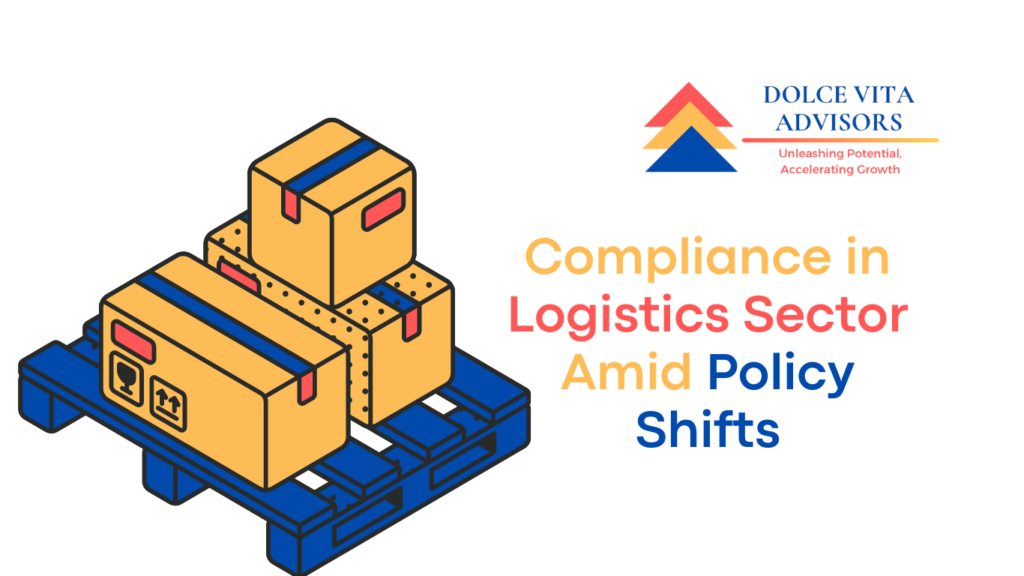
Insights by: Sumit Kochar & Jaydeep Saha
The Indian logistics sector is on a transformative journey, driven by a potent combination of robust economic growth, burgeoning e-commerce activity, and a renewed government focus on infrastructure development and policy reforms. This sector, once plagued by inefficiencies and high costs, is now poised to become a critical engine propelling India’s economic ambition. Today it is a a significant contributor to the national economy, accounting for 14.4% of Gross Domestic Product (GDP) and projected to reach a value of $380 billion within the next two years. The phenomenal rise in freight traffic in India has been a key catalyst for the logistics sector’s growth. This surge can be attributed to several factors:
Government Initiatives: The government has played a pivotal role in fostering the sector’s development. The introduction of the warehousing policy, which incentivizes the creation of exclusive warehousing zones through public-private partnerships, has addressed critical storage infrastructure needs. The government’s focus on infrastructure development, including projects like Dedicated Freight Corridors (DFCs) and multi-modal logistics parks (MMLPs), is further enhancing connectivity and boosting efficiency. Additionally, recognizing the critical role that the logistics sector plays in driving economic growth, the Indian government has introduced the National Logistics Policy (NLP) in 2022. This policy aims to bring down logistics costs from the current 16% of GDP to the global average of 8%. The NLP outlines a four-pronged approach to achieve this objective:
- Integration of Digital Systems (IDS): This initiative focuses on creating a seamless and secure platform for real-time or near real-time information exchange between various stakeholders, including producers, government bodies, customs, shippers, and service providers.
- Unified Logistics Interface Platform (ULIP): This technology-driven framework aims to bridge existing gaps and improve visibility across the logistics chain. ULIP will facilitate faster clearances, reduce delays, and ultimately contribute to lower transportation costs.
- Ease of Logistics (ELOG): This initiative aims to streamline regulatory processes and reduce the compliance burden on logistics companies.
- Service Improvement Group: This group will focus on identifying and addressing service delivery gaps within the logistics sector.
The Global Manufacturing Shift: India’s emergence as a favourite manufacturing destination for international firms has significantly impacted the logistics landscape. The relocation of manufacturing bases has led to a surge in demand for warehousing and logistics services. This trend is further amplified by the Production Linked Incentive (PLI) scheme, which incentivizes domestic production, leading to a growth in industrial space and warehousing requirements.
E-commerce Boom: The meteoric rise of e-commerce has fundamentally reshaped the logistics sector. The demand for faster deliveries, efficient last-mile connectivity, and value-added services like easy returns has necessitated a robust and agile logistics network. This has fuelled the growth of tech-driven logistics startups and innovative solutions that cater to the specific needs of e-commerce players.
New-Age Startups: The emergence of a vibrant startup ecosystem in the logistics sector has brought a wave of innovation and competition. These startups leverage cutting-edge technologies like artificial intelligence (AI), machine learning (ML), and the Internet of Things (IoT) to optimize processes, improve efficiency, and enhance transparency. This infusion of technology has not only revolutionized warehousing and transportation management but has also empowered customers with real-time tracking and greater visibility into their shipments.
Challenges
Despite the positive strides, the Indian logistics sector still faces some significant challenges that need to be addressed:
High Logistics Costs: Logistics costs in India remain significantly higher (14-18% of GDP) compared to the countries like China having around 8%. This disparity hinders the competitiveness of Indian products in the international market. Fragmented infrastructure, limited modal integration, and regulatory hurdles contribute to this inflated cost structure.
Fragmented Infrastructure: The current infrastructure landscape presents a challenge. The lack of seamless connectivity between road, rail, waterways, and airways creates bottlenecks and inefficiencies. This fragmentation leads to delays, increased transportation times, and higher costs.
Skill Gap: The Indian logistics sector suffers from a significant skill gap. There is a dearth of qualified professionals with expertise in areas like supply chain management, logistics planning, and data analytics. This lack of skilled manpower hinders the adoption of new technologies and efficient operations.
Regulatory Burden: One of the most significant challenges faced by the Indian logistics sector is the complex and fragmented regulatory environment. Companies operating in this industry are subject to a multitude of compliance obligations across various levels of government (central, state, and municipal). These obligations span diverse categories such as finance & taxation, secretarial, labor, commercial, industry-specific regulations, and environment, health & safety (EHS). The sheer number of registrations, approvals, licenses, permissions, consent orders, and certifications required creates a cumbersome process with overlapping and often unclear documentation.
Further compounding the issue is the lack of a centralized information portal. Businesses must navigate a labyrinth of several hundred acts and rules, the specific requirements of which vary depending on the size and geographical footprint of their operations. Examples include the Carriage by Road Act, 2007 & Carriage by Road Rules, 2011, and the Warehousing (Development and Regulation) Act, 2007 & Warehousing (Development and Regulation) Registration of Warehouses Rules, 2017. The inconsistent implementation of these regulations across different levels of government adds another layer of complexity.
The impact of this regulatory burden is particularly acute for Micro, Small, and Medium Enterprises (MSMEs) operating in the logistics sector. An MSME with a single corporate office, a single warehouse, and operations confined to a single state may still be required to obtain at least 84 one-time registrations and permissions. Additionally, they must grapple with 648 annual compliance requirements, a significant portion (226 or 34.8%) of which carry the risk of imprisonment for non-compliance.
The Role of Technology and Infrastructure Development
The Indian government is actively working on a multi-pronged approach to address these challenges and unlock the full potential of the logistics sector:
NLP: The NLP recognizes the importance of technology in transforming the logistics landscape. Initiatives such as ULIP and the increasing adoption of cloud-based systems for managing logistics and supply chains are paving the way for greater operational transparency and data-driven decision-making. Additionally, the integration of blockchain technology holds promise for further enhancing inventory management and business efficiency.
Digital Transformation: The government is actively promoting digitization in the logistics sector through ULIP and e-way bills. ULIP aims to create a single platform for seamless data exchange between various stakeholders, including government agencies, shippers, and logistics service providers. This streamlined flow of information will enhance transparency, improve visibility, and facilitate quicker clearances.
Investment in Infrastructure: The government is directing significant investments towards infrastructure projects like DFCs, MMLPs, and industrial corridors. These investments aim to improve connectivity between different modes of transport, reduce travel times, and create a more robust logistics. Furthermore, the PM Gati Shakti National Master Plan acknowledges the need for robust infrastructure development. The plan emphasizes an integrated approach to infrastructure and network planning, focusing on improving services (processes, digital systems, regulatory framework) and human resources.
Conclusion
The Indian logistics sector is poised for significant growth. However, addressing the challenges of regulatory complexity, infrastructure limitations, and automation needs will be crucial to unlocking its full potential. The initiatives outlined in the NLP, coupled with ongoing advancements in technology and infrastructure development, offer a promising roadmap for creating a more efficient, cost-effective, and globally competitive logistics ecosystem in India.

